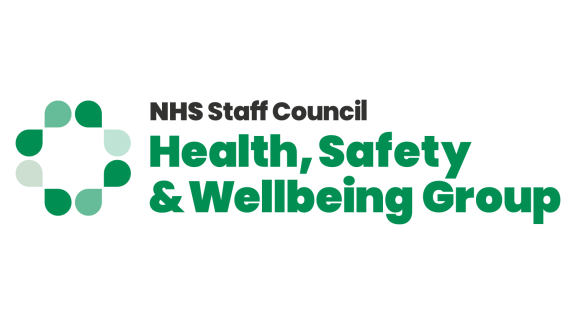
About the Health, Safety and Wellbeing Group
The Health, Safety and Wellbeing Group (HSWG) is a sub-group of the NHS Staff Council. It is a tripartite group involving staff side representatives from healthcare unions, management side representatives from NHS organisations and specialist members, such as the Health and Safety Executive, and the Institute of Occupational Safety and Health with a remit to do the following:
- to raise standards of workplace health, safety, and wellbeing in healthcare organisations
- to promote a safer working environment for all healthcare staff
- to promote best practice across both the NHS and the Independent sector.

This guidance was produced through partnership working between unions, management and specialist advisors. The group wishes to ensure this guidance is implemented with the same partnership approach. HSWG recognises that partnership working ensures best outcomes for patients and staff in protecting their health, safety and wellbeing.
Other HSWG resources to support you in your organisation can be found here.
Introduction
This guidance aims to raise the importance of partnership working on health, safety and wellbeing issues and to encourage partnership working at a local level.
It provides information on:
- why organisations should work in partnership on the health, safety and wellbeing agenda
- the functions of a health and safety representative
- what an effective health and safety committee looks like
- the legal requirements to consult on health and safety matters
- workplace inspections, including the legal requirements.
There are useful checklists throughout, which you can use to see what progress your organisation is making, as well as what needs to be done.
The document is aimed at managers and trade union health and safety representatives. It is also a useful reference for senior managers to assist them in meeting their legal duties to consult with the workforce on health and safety matters, and to have a better understanding of the role trade union health and health and safety representatives can play in improving the working environment.
The document makes several references to the Francis report. While the Health, Safety and Wellbeing Group recognises that the Francis report is over 10 years old, we suggest that the recommendations are still relevant to today's NHS, in particular with regards to the engagement and involvement of staff.
Why work in partnership?
Healthcare workers encounter a wide range of workplace hazards and many roles can be both emotionally and physically demanding. There is also an expectation for the NHS to be an exemplar in terms of promoting good health and supporting staff to lead healthy lifestyles.
The people best placed to make workplaces safer and healthier are the staff and managers who work in them. While we each have responsibilities for health and safety, we can do this much better when we work as a team – working together to achieve the shared aims of a workplace that is healthy and safe for all.
The Health and Safety Executive (HSE) points to the benefits of worker involvement in relation to health, safety and wellbeing, including a more positive health and safety climate, better control and greater awareness of workplace risks. Furthermore, the Royal College of Physicians states that the engagement of staff and their representatives in workplace health and wellbeing initiatives is an important element to the success of such initiatives.
The HSE suggest that building on what is required by law enables organisations to create a genuine partnership between senior managers and their representatives to manage health and safety risks. It creates a culture of collaboration where concerns, ideas and solutions are freely shared and acted upon, and where the whole workforce is engaged in promoting a healthy and safe environment. This means there is greater potential for improvements to health and safety for your organisation.
"Partnership working on health, safety and wellbeing issues is an effective means of supporting workforce involvement and engagement"
Partnership working on health, safety and wellbeing issues is an effective means of supporting workforce involvement and engagement. Strategies on engagement should recognise the value of existing mechanisms for staff involvement, such as local negotiating machinery and structures for sharing information and gathering views.
The influential Francis report highlighted how staff disengagement can lead to a downward spiral into poor care. Francis also identified how under-staffing and lack of leadership can lead to unacceptable stress levels, leading to increased sickness absence in staff. He stated: “Staff in the difficult environment of a hospital deserve and are entitled to support, respect and recognition for good standards. They should not have to contend with a culture of fear and bullying”.
The Berwick report into patient safety also called on leaders and managers of NHS-funded provider organisations to actively support staff through excellent human resource practices, promoting staff health and wellbeing, cultivating a positive organisation climate and involving staff in decision-making and innovation.
In their guidance on leadership and health and safety, the Institute of Directors and the Health and Safety Executive recognise that worker involvement and engaging the workforce in the promotion and achievement of safe and healthy conditions is an essential principle of good health and safety performance.
A secondary analysis of government statistics calculated the savings delivered by unions across the economy and showed that the union's role in the prevention of workplace injuries and work-related ill health contributed to savings of £219 million to £725 million a year.
Furthermore, the HSE recognises and supports the vital contribution health and safety representatives, and trade unions make to maintaining and improving health and safety in the workplace.
To summarise, engagement through working in partnership with local union representatives to ensure that staff are kept safe and healthy at work is essential in healthcare environments. Subsequent improvements in staff health, safety and wellbeing will have a positive impact on patient safety and the quality of care and lead to cost savings.
Health and safety representatives
Trade union health and safety representatives can work in partnership with employers to support improvements in staff health, safety and wellbeing. When given the resources to carry out their role effectively, they can support the early identification and correction of unsafe conditions and working practices.
Under the regulations, health and safety representatives are entitled to “such time off as is necessary to carry out their role”. In his recommendations, Sir Robert Francis recognised the importance of worker representation in the health sector and called on stakeholders to ensure that adequate time is allowed for staff to undertake the representation role.
Health and safety representatives have several functions which are enshrined in law, namely the Safety Representatives and Safety Committee Regulations 1977 and The Safety Representatives and Safety Committees Regulations (Northern Ireland) 1979.
Employers must allow safety representatives the time and facilities necessary to carry out these functions. A list of functions is detailed below.
Employers also need to be aware there is a legal duty to consult with trade union safety representatives on matters relating to health and safety.
Functions of a health and safety representative
- Investigate potential hazards and dangerous occurrences in the workplace – whether or not employees draw them to the attention of the representative – and examine the causes of the accidents.
- Investigate complaints by any employee whom they represent that relate to the employee’s health, safety or welfare at work.
- Take complaints and other health and safety problems to the employer.
- Carry out inspections of the workplace.
- Represent their employees’ interests in consultations with the HSE inspectors and any other enforcing authority.
- Receive information from HSE inspectors.
- Attend meetings of safety committees.
Heath and safety representatives - employer checklist

Do you have mechanisms in place for working in partnership on health, safety and wellbeing?
Is there a commitment from board and senior management on partnership working on health, safety and wellbeing?
Is there a commitment from partnership forums to engage with health and safety representatives and committees on matters affecting the health, safety and wellbeing of staff, for example, policies on violence or changes to shift patterns?
Do human resources and line managers understand the role of health and safety representatives and their right to time off to carry out functions?
Are health and safety representatives given opportunities to engage and work with specialist staff such as security management specialists, occupational health, and health and safety advisors?
Health and safety committees
The Francis report (2013) stated that staff in the difficult environment of a hospital deserve and are entitled to support, respect and recognition for good standards. An effective, well-organised health and safety committee, with managers and safety reps committed to constructively working together, can ensure staff are kept safe and healthy at work. Such a partnership can generate a safety culture which complements and promotes high standards of patient safety and quality of care.
What does an effective health and safety committee look like?
The measure of a good health and safety committee is whether or not it can secure change by creating a strong safety culture in the workplace. The HSE advises that an effective committee should have:
- senior managers on the committee with the authority to make decisions so action can be taken quickly
- shared responsibility and commitment from managers and safety reps (members of the committee) to achieve their agreed aims – an important crucial factor for success
- competent and well-trained committee members who are confident in their role and can fulfil their responsibilities. They can remove potential hazards, to reduce incidences of injuries, sickness absence and stress in the workplace
- committee members who understand the importance of robust risk assessments promptly undertaken by properly trained competent people – particularly for services about to be restructured or introduction of new technology that can affect the wellbeing and safety of the workforce
- a reasonably compact and compatible size to ensure sufficient representation of managers and health and safety reps. The number of managers should not exceed the number of health and safety reps
- specialists who are co-opted for particular meetings when there is discussion on subjects for which their expertise is required
- meeting dates are agreed and known in advance and only get postponed by mutual agreement
- accurate, concise minutes with action points produced promptly improve morale among staff and managers as they see problems quickly resolved.
Case study – example of a health and safety committee in action
The physiotherapy health and safety reps brought their body mapping survey results to their local health and safety committee. Their findings exposed a common complaint among physiotherapists who were complaining of aches and pains after two weeks of using new portable electronic display equipment purchased for inputting patient notes.
Members of the safety committee reviewed the trust’s risk assessments for the introduction of new portable electronic devices and then re-assessed the new technology in close consultation with relevant experts and affected staff. This highlights the strength of having a safety committee that provides a forum which takes a broader, more long-term look at health, safety and wellbeing issues than an individual manager or safety rep working on their own is capable of achieving.
Legal considerations for health and safety committees
Under the Health and Safety at Work Act 1974 and the Health and Safety at Work (Northern Ireland) Order 1978, the health and safety committee’s role is keeping under review the measures taken to ensure the health and safety at work of employees.
The main regulation that covers the subject of health and safety committees is the Safety Representatives and Safety Committee Regulations 1977 and The Safety Representatives and Safety Committees Regulations (Northern Ireland) 1979.
If two or more safety representatives request in writing that the trust set up a safety committee, this must be done within three months.
Employers are required to:
- consult the health and safety reps who made the request and other recognised unions on how the committee should function
- inform all employees by posting a notice in a prominent position stating the composition of the committee and the work areas it will cover.
Is your health and safety committee fit for purpose?
See the health and safety committee checklist in a new page: https://tinyurl.com/mrkph9bz
The benefits of consultation on health and safety
When changes are planned to a working practice or the working environment, the health and safety implications of the change can often be overlooked. Resolving health and safety problems after the change is made can:
- be costly
- delay the delivery of services
- result in injury or ill health to staff members, patients or the public.
Health and safety representatives can play a key role in both supporting employers to identify the health and safety risks from planned changes and explaining safety measures to the workforce and gaining commitment.
Similarly, when new pieces of equipment are being introduced it makes sense to get the views of the end user on the choice of equipment.
There is also a legal duty on employers to consult in ‘good time’ with health and safety representatives on changes which have the potential to affect the health and safety of members they represent.
Regulation 4: The Safety Representatives and Safety Committee Regulations
Regulation 4 requires every employer to consult health and safety representatives in good time on:
- the introduction of any measure at the workplace which may substantially affect the health and safety of the employees the health and safety representatives concerned represent
- the health and safety consequences for the employees the safety representatives represent of the introduction (including the planning stages) of new technologies into the workplace.
There is also a requirement to consult on the arrangements for appointing ‘competent persons’ to assist the employer meet their health and safety duties, the planning and organising of any health and safety training and health and safety information provided by the employer.
Examples of when to consult
Below are some illustrative examples of issues when health and safety representatives should be consulted:
Changes to shift patterns – poorly planned shift patterns can impact negatively on the safety of staff and patients. Safety representatives can work with employers to ensure that optimum shift patterns are put in place employers for safety and health and compliance with the working time regulations.
Changes to staffing levels or skill mixes – changes to staffing levels or skill mixes can have a detrimental effect on staff as well as patients. Working under excessive demands and pressure can lead to stress, whilst being pressured to work beyond your competencies and skills can also be stressful. Health and safety representatives should be consulted on any changes to staffing which have the potential to lead to stress and ill health in the workforce.
Introduction of new technology – health and safety representatives can voice the views or concerns of the workforce in relation to the introduction of new technology, eg lone worker alarms, laptops/tablets in the community or sharps safety devices. Getting the views of employees through their safety representatives may help employers avoid costly mistakes in procurement.
Refurbishment of a unit or changes to the physical environment – again, getting the views of employees through health and safety representatives may help employers avoid costly mistakes in environmental design or developing an environment which presents risks to health, safety and wellbeing. Those working in the environment day in and day out are best placed to give views on planned changes to the environment.
Competent persons – health and safety representatives should be consulted by the employer on the arrangements for appointing competent persons such as health and safety managers; moving and handling advisors and occupational health services. In practical terms, this could mean consultation on service level agreements, job specification, interview questions and even being on the interviewing panel for the post.
Health and safety training and information – health and safety representatives should be consulted on the planning and development of health and safety training and health and safety-related information.
Further considerations when consulting
Consultation involves taking account of, as well as listening to the views of employees and must take place before decisions are made.
The regulations state that consultation must be in ‘good time’. The HSE states that ‘good time’ means before making decisions involving work equipment, work process or work organisation which could have health and safety consequences for employees.
Employers must allow time to:
- provide health and safety representatives with information about what they propose to do
- give the health and safety representatives an opportunity to express their views about the matter in the light of that information
- take account of any response.
Regulation 4 - employer checklist

Does your policy or health and safety strategy adequately capture and ensure that safety representatives are consulted on health and safety matters?
Do you plan consultation with health and safety representatives into project plans?
Do project plans factor in time for the consultation process outlined above?
Workplace inspections
Regular workplace inspections provide an opportunity to proactively pick up on any health, safety and wellbeing issues which have the potential to cause injury or ill health to staff, patients and visitors.
Issues such as blocked fire exits, over-full sharps bins and poorly maintained equipment are all issues that have been picked up by health and safety representatives carrying out inspections in hospital environments.
Similar issues have also been picked up in inspections by various healthcare regulators, including the Care Quality Commission (CQC) and the Health Inspectorate for Wales. Such issues can often highlight failures in safety culture or systemic problems.
Through critical examination of the workplace, inspections identify and record hazards for corrective action. Health and safety committees can help plan, conduct, report and monitor inspections. Regular workplace inspections are an important part of the overall occupational health and safety program.
The HSE sees advantages in formal inspections being carried out jointly by the employer representatives (such as an estates lead or health and safety/risk manager) and health and safety representatives, but points out that this should not prevent health and safety representatives carrying out independent inspections or private discussions with employees.
Under Regulation 5 of the Safety Representatives and Safety Committee Regulations 1977 and The Safety Representatives and Safety Committees Regulations (Northern Ireland) 1979, health and safety representatives are entitled to carry out regular formal inspections of the workplace.
Below is a list of the circumstances when a representative can inspect:
- the workplace has not been inspected for three months
- there has been a substantial change in work conditions
- there has been a notifiable accident, illness or dangerous occurrence
- new information becomes available relevant to the hazards in the workplace
- a member complains about health and safety in the workplace
- if the safety representative believes there is a potential hazard that should be investigated.
Workplace inspection checklist

Are health and safety representatives able to carry out workplace inspections in line with the Safety Representatives and Safety Committee Regulations?
Do you have a calendar of regular workplace inspections in place?
Are inspections carried out jointly?
Are health and safety representatives able to carry out independent inspections if requested?
Are the recommendations of inspection reports and remedial action acted on in a timely manner?
Is there a process in place for monitoring remedial actions following inspections?
Are unresolved issues escalated through health and safety committees?
There is a legal right to carry out an inspection if written notice has been provided to the employer. Best practice would be to agree on a formal calendar of regular inspections and ensure that both managers and safety representatives can schedule time to carry out a joint inspection.
A safety inspection generally involves a walk-through of the workplace, inspection of relevant documents (eg risk assessments or training records) and speaking to staff.
If the workplace area is fairly large or complicated it may not be practical to conduct a formal inspection of the workplace in a single session or for the same health and safety representatives and manager to carry out all the inspections. In these circumstances, arrangements should be made to break up inspections into manageable units.
Healthcare trade unions will have standard inspection checklists for their health safety representatives to use and these can be adapted accordingly. Cameras are another useful resource to have when carrying out an inspection. The HSE has developed a standard reporting form for inspection, which can be found here.
One trust has commenced hazard spotting, walk-around tours involving safety representatives and estates and facilities. They use cameras and take photographs of hazardous conditions, reducing the need for time spent on reports, which has enabled a speedy resolution to most issues.
Further information on workplace health and safety
Our full range of guidance and resources published by the NHS Staff Council Health, Safety and Wellbeing Group (HSWG) can be found on our dedicated HSWG web page.



